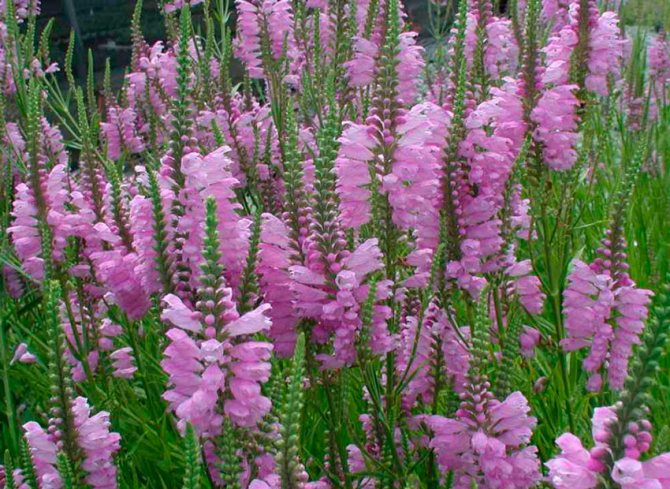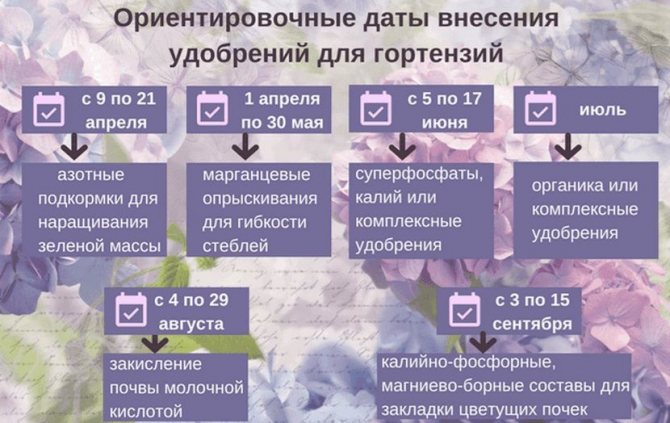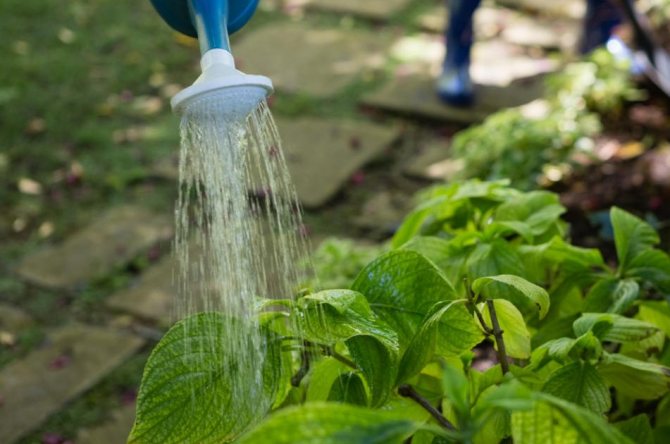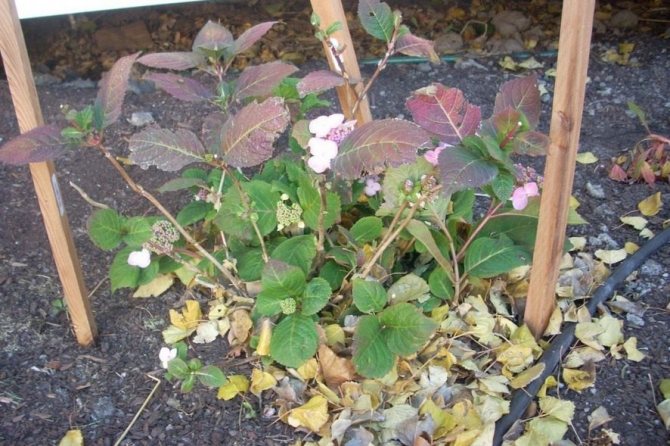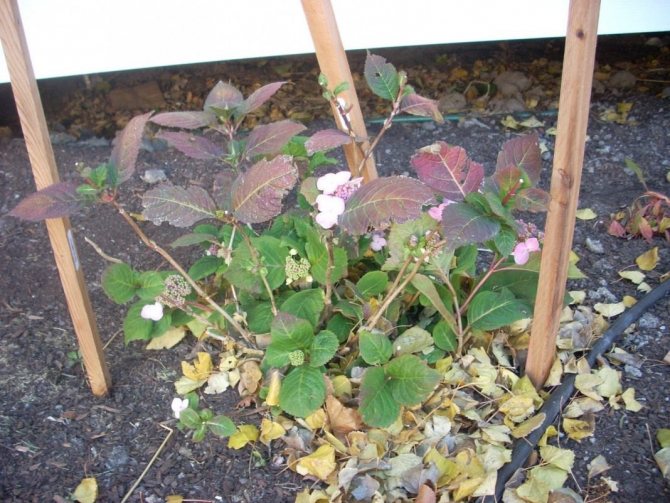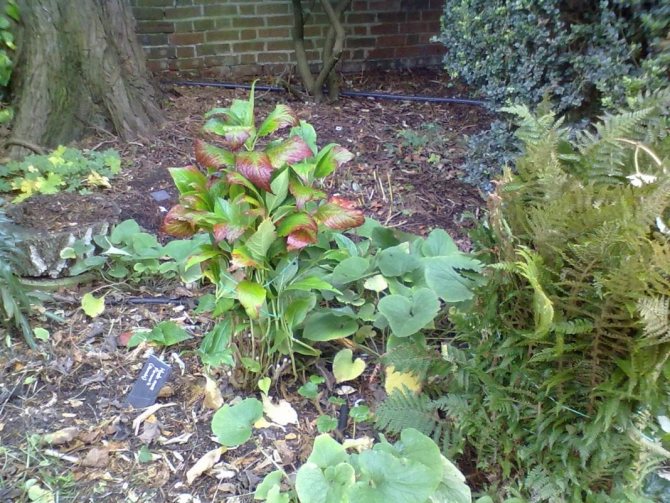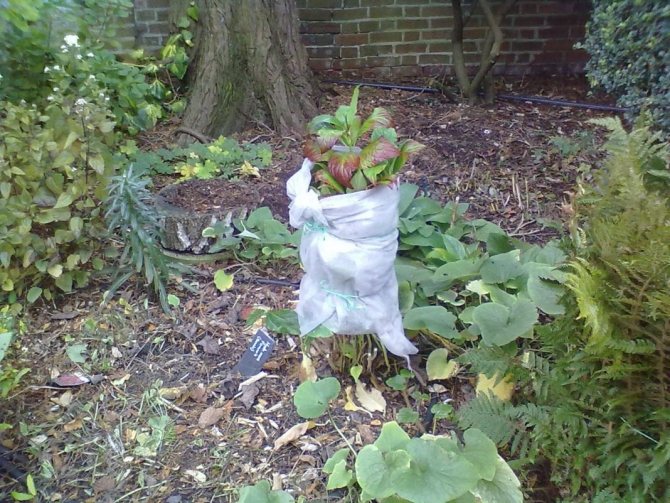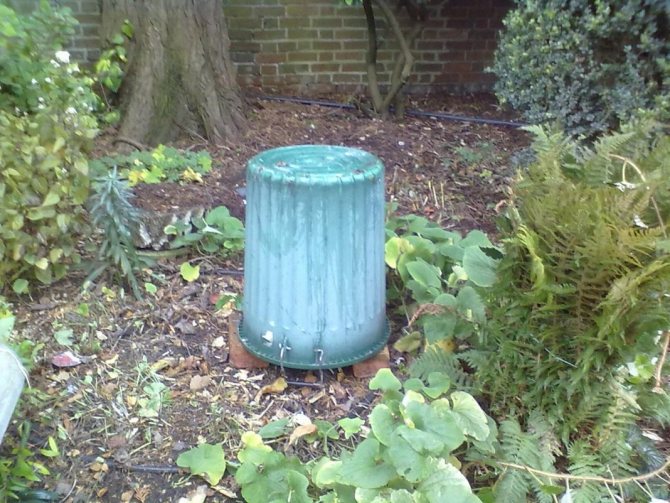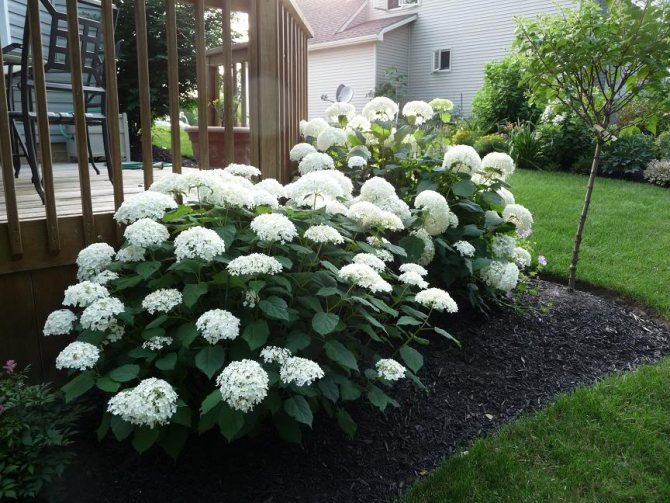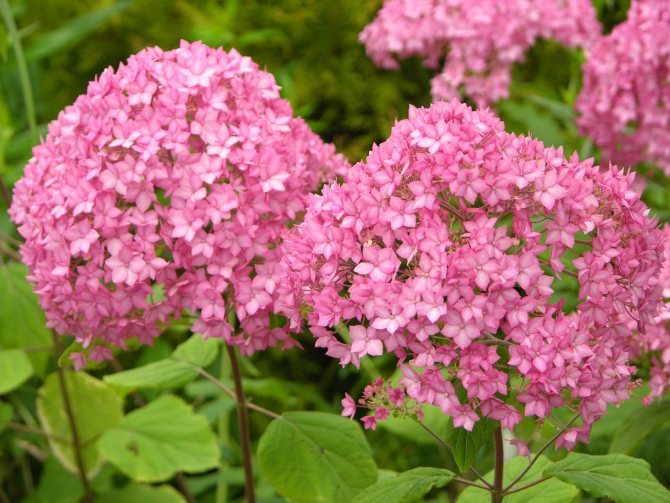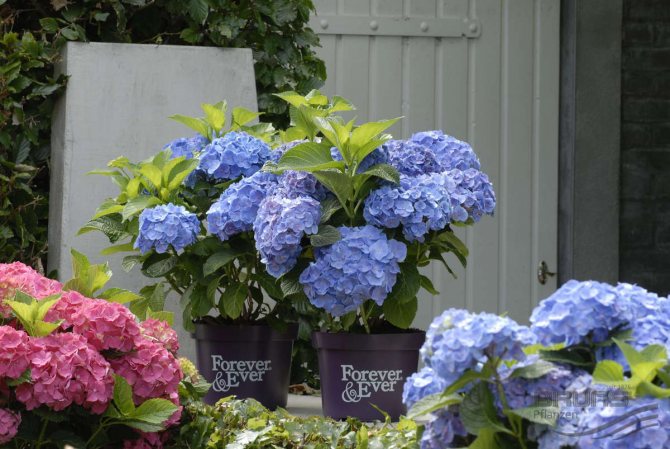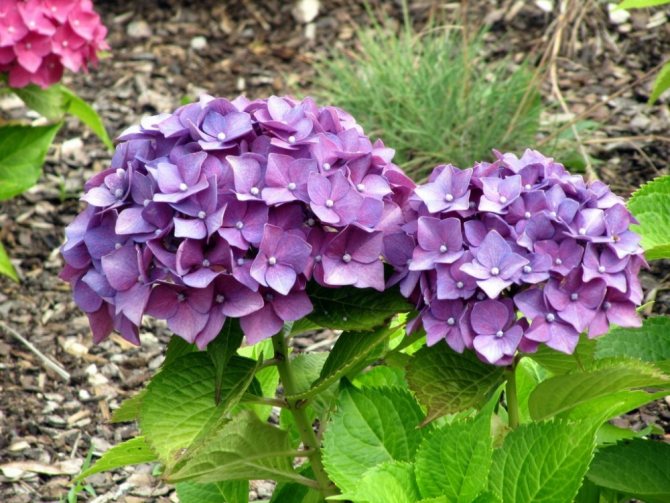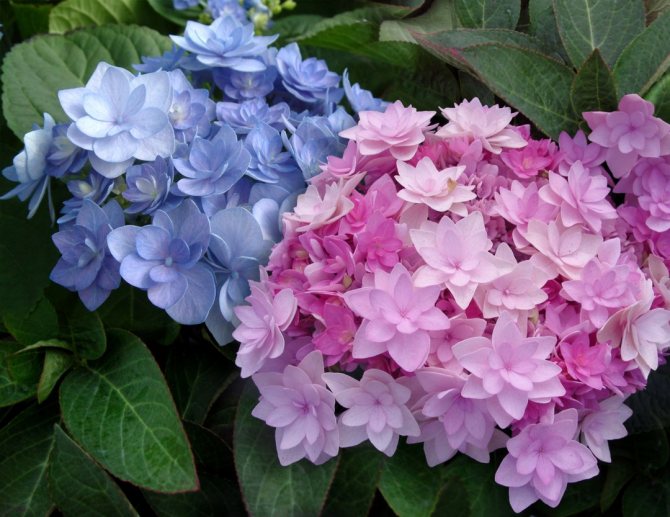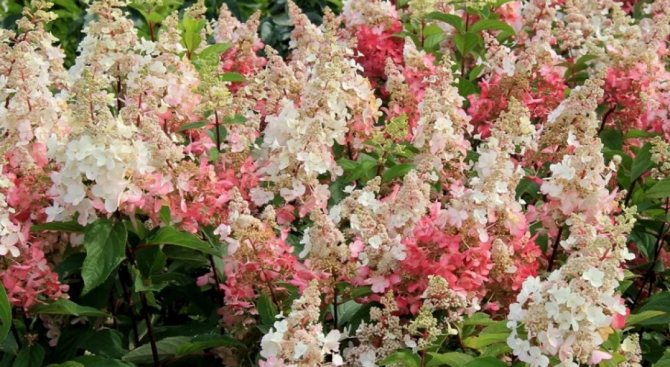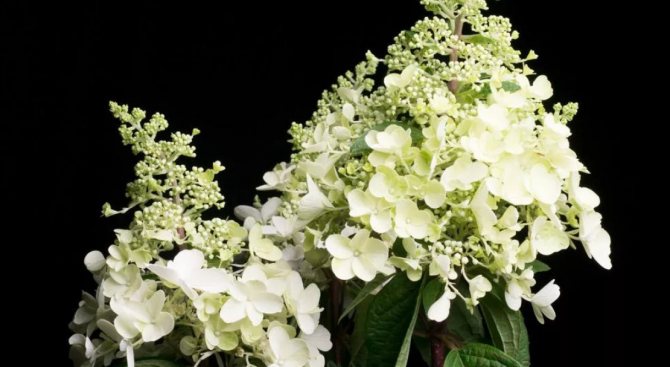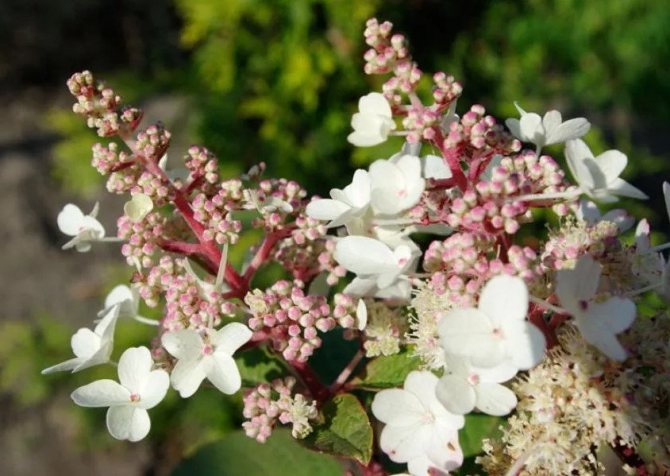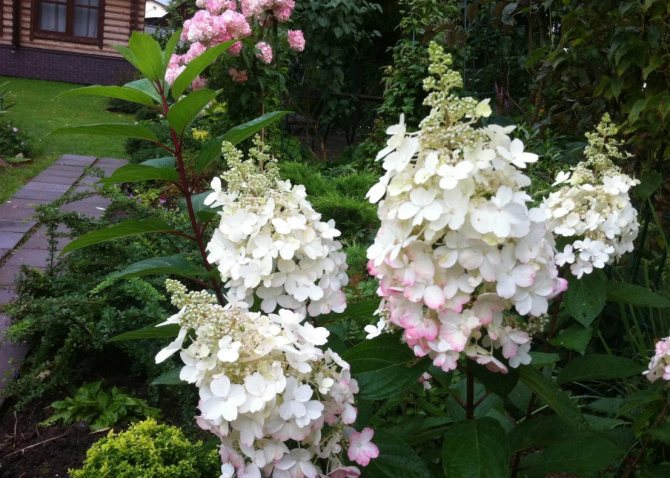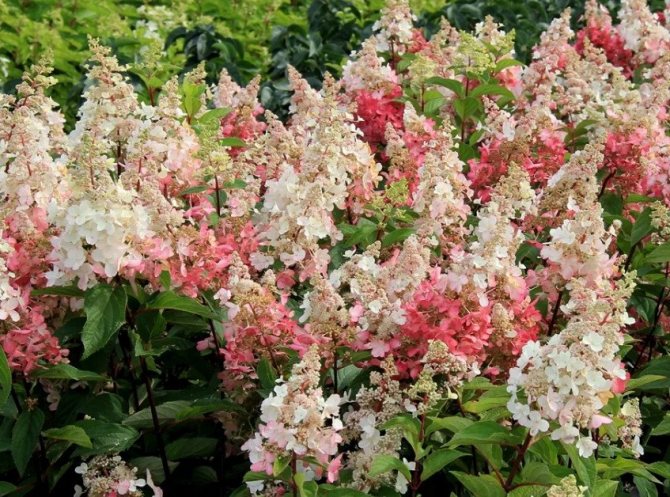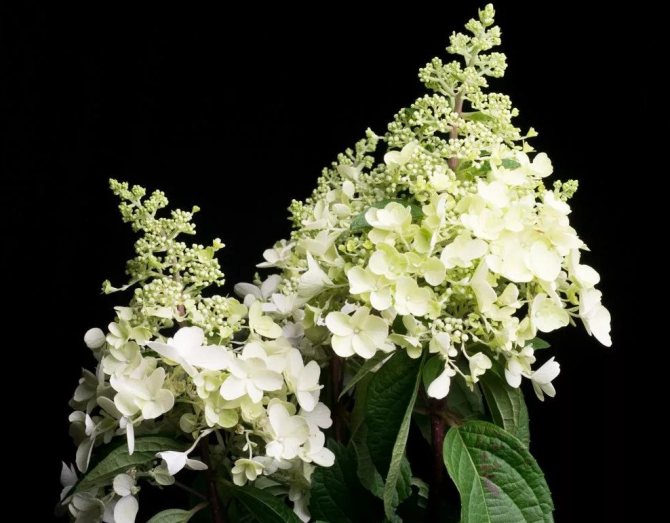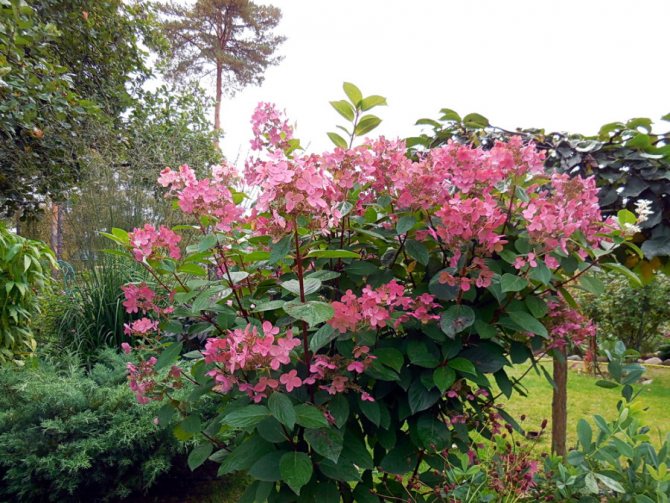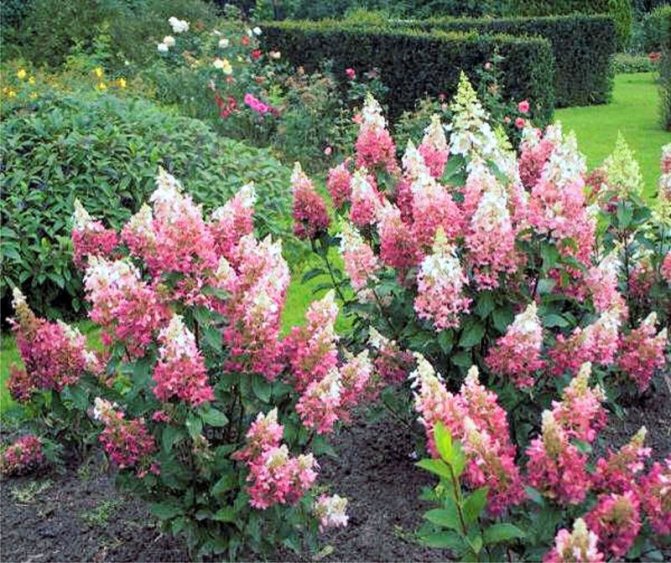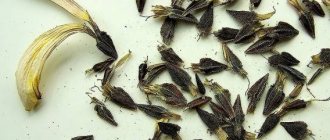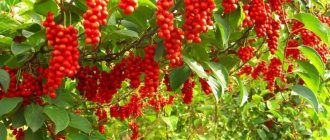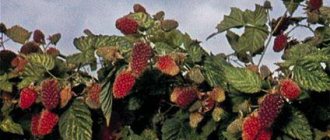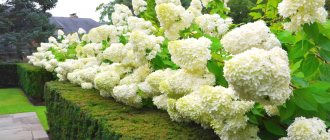One of the most attractive ornamental shrubs for a suburban area is the Sargent hydrangea. Large, rough leaves and delicate purple inflorescences attract the attention of passers-by and emphasize the exquisite taste of the garden owners. Receiving proper care, the shrub pleases those around it with a lush crown and abundant flowering for a long time.

Hydrangea Sargent very poorly tolerates low temperatures
Growing features
The soil around the rough hydrangea bush is loosened three times per season. This is done very carefully so as not to damage the root system. Insufficient soil moisture can cause poor plant development. During dry periods, hydrangea is watered every three days. If the weather is cloudy and rainy, then the frequency of watering is reduced to once a week. To keep moisture longer, the trunk circle is mulched with peat.
The first two years after planting, the rough hydrangea does not need feeding. Starting from the third year, it is recommended to feed it with a special complex of fertilizers every spring. During the formation of buds, hydrangea is fertilized with superphosphate or potassium sulfate.
In the third year after planting, the bush is pruned annually in March to prevent excessive density. Also, in the spring, damaged shoots are removed and last year's shoots are shortened by three buds. This helps to give the hydrangea bush a beautiful decorative shape.
Hydrangea suffers from spider mites, aphids and weevils. To get rid of these pests, the plant is treated with insecticides. Rough hydrangea bushes can be sick with powdery mildew. At the same time, oily specks appear on the foliage. To overcome this disease, the bush is treated with foundation. Hydrangea is also prone to chlorosis, which a solution of ferrous sulfate helps to cope with.
Rough hydrangea is considered a frost-resistant species. However, experts recommend covering the tree trunk circle with sawdust or fallen leaves for the winter.
Hydrangea Sargent in landscape design
In landscape design, Sargent's hydrangea has found wide application. Lush neat bushes can be an accent or complementary element of many landscaping styles. Sargent's rough hydrangea is appreciated for the opportunity to experiment with ideas, because it is almost universal in application.
Features of Sargent hydrangea as a design element:
- In a single planting, it focuses on itself due to its high decorative effect.
- Contrasting floral arrangements give tenderness and uniqueness.
- With plantations of coniferous and deciduous shrubs, it forms a complete picture.
- Alleys and hedges are extraordinarily spectacular.
- It is in perfect harmony with the lower plants in the mixborder.
- Looks graceful in container fit.
Important! When creating group plantings with Sargent hydrangea, you need to select crops that also love moist soil.
Planting / transplanting, reproduction
For planting hydrangeas, choose a well-lit area without direct sunlight and drafts. The soil on the site must have neutral acidity. Three-year-old seedlings are best suited for planting in open ground. The disembarkation procedure can be carried out in spring or autumn. To do this, prepare holes with a drainage layer of broken brick and crushed stone.The diameter of the planting hole should not exceed 60 cm. Part of the soil is added on top and a seedling is placed, the rhizomes of which are carefully distributed. The hole is covered with soil residues so that the root neck protrudes above the surface. The soil is compacted and watered. When planting in dry weather, the seedlings are sprayed with water.
The rough hydrangea is propagated in several ways.
- Propagation by cuttings. The procedure is carried out after the appearance of the buds. As a rule, this falls in mid-July. In the early morning, shoots with large buds are cut off. They are placed in a vessel with water and the green top is removed. Each process is divided into parts so that there are three leaves on each. In this case, the lower ones are removed completely, and the remaining ones are trimmed. The cuttings are placed in a rooting stimulator for several hours. Sand and peat are added to the soil at the planting site, then the cuttings are moistened and planted. Each is covered with glass jars. The cuttings are watered every week. After about 30 days, they will start to take root. After that, banks are removed from them and covered to protect them from the first frost. Before winter, the cuttings are covered with hay and fallen leaves. Seedlings can be planted on a permanent bed only when they grow up to 45 cm.
- Reproduction by seeds. Soil is poured into the container, moistened and seeds are placed in it. Cover with polyethylene on top. As it dries, the soil is watered. The first shoots can usually be seen after three weeks. The seedlings are grown for at least two years, and only after that they are transplanted to the garden bed.
- Reproduction by layering. The procedure is carried out before the buds open in the first weeks of spring. The soil next to the bush is dug up and small grooves are made in it. The lower shoots are laid out in them, fixed, watered a little and sprinkled with earth. Young shoots begin to appear in early autumn. When they are at least 20 cm high, they are added dropwise. After 10 days, the shoots are spud. The procedure is repeated until the mound reaches 25 cm In the second half of October, the layers are dug up and carefully separated. The seedlings are buried in the ground, and in the spring they are planted in the garden for growing. They are transplanted to a permanent place only after a year.
- Reproduction by dividing the bush. In the first months of spring, hydrangeas are abundantly watered and dug up. Then, very carefully, the root system is cleaned of soil and washed. After that, the bush is divided into several parts, get rid of all damaged roots and treated with a root formation stimulant. The cuttings prepared in this way are immediately planted on the prepared bed.
Bella Anna
Bella Anna is a variety with large, decorative inflorescences that can reach 25-35 cm in diameter.
Flowers of bright pink color acquire a raspberry hue from the first days of flowering. The flowers are actinomorphic in shape with five petals, pointed at the end.
Did you know? To make the inflorescences larger, it is necessary to prune in the spring, cutting off the shoots up to 10 cm.
Despite the abundance of flowering, the bush itself is small and grows up to 130 cm. The shoots of the bush do not withstand a lot of color and bend to the ground. At the beginning of growth, the shoots are light green, and over time they turn brown. The leaves are ovoid, pointed to the edge, light green in color, and bright yellow in autumn. The variety is frost-resistant, flowering lasts a long time, because young shoots of the current year are blooming. Most often, the plant is used in group plantings and very rarely as a tapeworm. As for care, the plant needs to provide good drainage, because from stagnant moisture, the plant can get sick with gray rot.
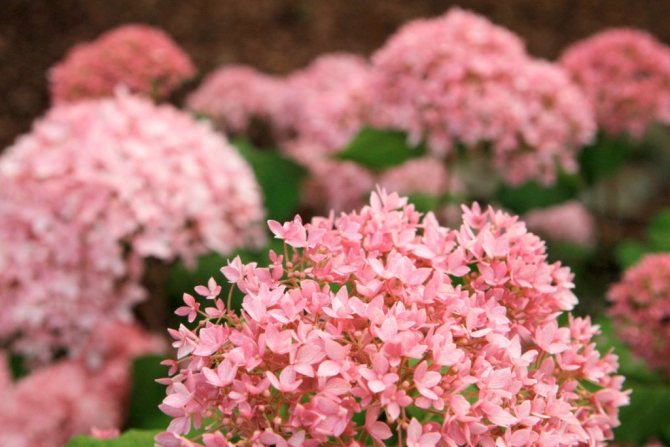

Hydrangea aspera
Add to bookmarks:
Synonyms:
Hydrangea villosa, Hydrangea aspera Buch.-Ham. ex D. Don, Hydrangea aspera D. Don
(Hydrangea aspera) is a species of deciduous shrubs or small trees from the genus Hydrangea of the Hydrangaceae family. The range extends to the region between the Himalayas, through northern and central China, to Taiwan.
It is a small deciduous tree or shrub 1.5-3 (4) m in height and 1.5-2 m in diameter. The bush is erect, densely branched, dense. Shoots are weakly spreading, densely covered with rough and outstretched hairs, fleecy from pubescence, later more or less bare. The bark is brown or gray-brown, flaking.
Hydrangea aspera ssp. sargentiana
Leaves are 9-25 cm in length and 3-9 cm in width, lanceolate, narrow-ovate to oblong-oval, pointed with a pointed, retracted apex or wedge-shaped, retracted, narrowed, acuminate. The base of the leaf blade is rounded or broadly wedge-shaped, with a finely or finely serrated edge, the upper part is sparsely and coarsely hairy, rough, the lower part is densely fleecy, gray from pubescence. The petioles are dense, short, gray-haired, reddish.
Inflorescences are corymbose, 15-20 (25) cm in diameter, rather flat, axillary and apical. Sterile flowers are located in several pieces or numerous, peripheral, up to 2.5 cm in diameter. Pedicels are long, fleecy. Petals are rounded, often toothed, 4 in number, white, purple, pale pink, with darker veins. Fertile flowers are small, numerous, pink or lilac-blue. Blooms from August to September.
Fruit
- dry boxes of green, and later brown.
Subspecies:
- var. angustifolia Hemsl,
- var. sinica Diels,
- subsp. Robusta
Varieties:
Hot Chocolate, Taiwan Pink, Kawakamii
Frost resistance zone:
6-7 (-23 ° C).
Location:
It is thermophilic, demanding on moisture, does not tolerate direct sunlight. Needs a place protected from wind and cold.
The soil:
prefers fertile, neutral or slightly acidified soil.
Landing
: the optimal age for planting is 2-3 years. Planting is best done in spring or fall. The size of the planting pit on light cultivated soils is 40x40x50 cm, on loamy cultivated soils - 50x50x60 cm, on heavy clay soils - 60x60x70 cm.It is recommended to place drains at the bottom of the pit in the form of gravel, broken brick with a layer of 5-10 cm. Fertile soil is poured over the drainage a layer of 10-15 cm. The roots are spread over the entire area of the pit, and the root collar is placed at soil level. Water consumption after planting per plant on sandy loam soil 20-25 liters, medium loamy 15-20 liters, heavy loamy 10-15 liters. In dry and windy weather, it is recommended to spray the plant immediately after planting.
Care
: At least 2 times a year, it is recommended to loosen the soil around the bush to a depth of 5 cm. Watering must be carried out at least 5 times a season. To increase the strength of the shoots, you can water a weak solution of potassium permanganate along the crown and under the root. Top dressing with manure or mineral fertilizers is carried out at the beginning of growth, during the period of bud formation, and also 1-2 times in the summer.
Cropping:
Pruning is carried out in late March - early April, cutting off a third of the skeletal shoots at ground level.
Reproduction:
easily propagated by green cuttings and bush division. Rooting rate of cuttings is 100% without treatment. Reproduces well by layering. Cuttings are best harvested during the flowering period; for this, the tops of the shoots of the current year are cut off. At the beginning of April, they dig a hole 60-70 cm deep and 50 cm in diameter. After that, a cutting is placed in it and covered with a prepared mixture. Soil mixture: humus, black soil, peat and sand in a ratio of 2: 2: 1: 1. Also add 20 g of urea, 30 g of potassium sulfate and 30 g of superphosphate. After 2 years, repeat a similar feeding.
Pests
: aphid (pelargonium, greenhouse, leguminous), greenhouse trip, slobbering penny, spider mite, green tree bug, berry bug, meadow bug, brilliant fawn leaf beetle, nettle leaf weevil, moths (caterpillars of moths), golden brown olives marsh centipede mosquito, earwig, rootworm nematode.
Diseases:
Tracheomycotic wilting, White sclerocial rot, Gray rot, Common (European) cancer, Tubercular necrosis of the bark, Powdery mildew, Phylostictic, septoria, annular and ascochitous spotting.
Using:
used in single and group plantings, for beautiful free-growing hedges, in decorative groups, in garden and park compositions.
In the garden there is one beautiful and rather whimsical plant - a rough macrophylla hydrangea. Just incredibly beautiful and super moody. It is famous for its beautiful blue flowers, but it does not tolerate frost very well. Although, in order to enjoy her unprecedented beauty during the flowering period, it is advisable to spend a lot of time every year, trying to take care of her with all her might.
As a rule, macrophylla begins to bloom from last year's shoots, and, for this reason, it is incredibly important throughout the winter to ensure that it does not freeze and is preserved.
Large-leaved hydrangea varieties
Variety Endless Summer
- The cultivar is tall.
- The bush can reach a height of 1.5-2.5 m.
- The crown diameter is 1.5 m.
- The homeland of this variety is North America.
- On the territory of the Russian Federation, the variety has gained significant distribution due to its beauty and unpretentiousness in the growing process.
- The leaves are dark green with jagged edges.
- The color of the buds largely depends on the acidity of the soil.
Thus, the color of the hydrangea of this variety can be regulated by artificially introducing various mineral additives into the soil. So if the soil is alkaline, then the flowers will have a purple color. And when aluminum sulfate is added to the soil, the color of the flowers becomes bluish.
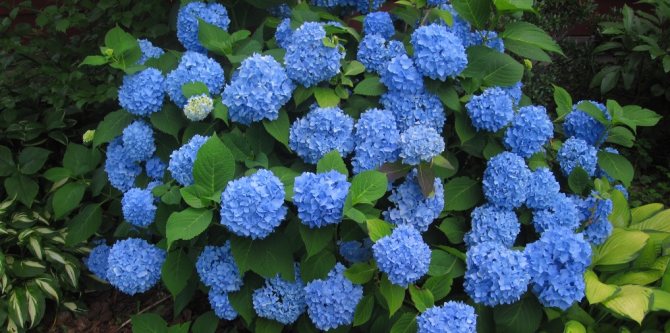

Reproduction and planting
The buds are located on both new and old branches. Flowering occurs in waves for six weeks. The Endless Summer variety propagates only by cuttings. Seed material is used mainly for breeding purposes. The selection and germination of the cuttings is carried out according to the generally accepted scheme. So, the lower leaves are removed from the cuttings 50-60 cm long and planted in a previously prepared container. The size of such a container should be 40 x 40 x 40 cm.
The soil substrate in this container should include peat (30%), calcined sand (60%) and rotted manure (10%). The cuttings planted in this way are placed in a mini-greenhouse. In the future, watering the cuttings and airing the greenhouse are carried out. After 4 weeks, the cutting takes root and can be transplanted into the open ground to a permanent growing area. To do this, prepare planting pits measuring 45 x 45 x 45 cm. 1.0-1.5 kg of rotted manure and 15 g of urea are placed at the bottom of the pit. After planting, the planted seedlings are watered, followed by mulching of the near-trunk space.
Watering and fertilizing
It should be remembered that plants of the Endless Summer variety do not like shaded growing areas. With a lack of light, small flowers are formed. Plants of this variety must be systematically watered at least 2 times a week. During the initial period of development, weed control must be carried out. The Endless Summer variety needs additional feeding during the growing season. So the first feeding is carried out in the month of May using poultry droppings diluted with water in a ratio of 1:10. 1 liter is consumed per plant. prepared solution. After applying top dressing, you need to water at a rate of 10 liters. for 1m2. The purpose of such irrigation is to deliver the applied fertilizer together with irrigation water to the root layer of the hydrangea. In the middle of summer, a second top dressing is carried out with the addition of 10 g of potassium fertilizer to the working solution. In addition to feeding, you need to prune shoots in early spring or late autumn after the cessation of sap flow.
The hydrangea variety Endless Summer is an excellent material for creating all kinds of flower arrangements in the process of landscaping your personal plot.
Hydrangea blue variety
This variety is unpretentious in cultivation and has a beautiful appearance.
- Plants of this variety reach a height of 1.5-2.0 m.
- The best way to propagate a variety is by cuttings.
- To do this, take the lower young shoots 7-8 cm long with 3-4 pairs of leaves on them.
- Cut the cuttings exactly at a distance of 4 cm from the first node.
- The lower leaves are removed.
- Cuttings are planted in containers filled with a mixture of sand (60%) and peat (40%).
- The container with cuttings on top must be covered with foil or glass.
- After 3-6 weeks, the blue hydrangea should take root.
- After that, the hydrangea is transplanted into separate pots.
Conditions: lighting and watering. Fertilizer
Hydrangea is very sensitive to light and watering. Watering should be carried out systematically as the soil dries up. If a plant of this variety lacks moisture, then its leaves turn yellow and curl. In the phase of flowering and active growth, the plant needs fertilizing with mineral fertilizers. For this purpose, it is more advisable to buy ready-made fertilizers in specialized flower shops. The consumption rate is 2 g of fertilizer per 1 liter. water.
Pruning
Pruning of plants is carried out in the spring before the growth of vegetative organs. During pruning, strongly elongated and weak shoots are removed. In addition, old inflorescences are removed. It should be remembered that heavily trimmed plants do not bloom well in the future. After pruning, the hydrangea plants need to be fed. Blue hydrangea can be negatively affected by pests and diseases.
Pests
Among pests, aphids are the most dangerous. To combat this pest, a soap solution is used. If the number of aphids is quite significant, then you need to resort to the use of insecticidal and acaricidal preparations. In the case of a strong reproduction of this pest, leaf twisting occurs.
Diseases
Downy mildew and chlorosis are the most dangerous diseases. Downy mildew appears on stems and leaves as oily spots with a white bloom. For the treatment of affected plants, a solution of copper sulfate (10-15 g) and soap (150 g) is used. Chlorosis on hydrangea plants manifests itself in the form of light leaves with dark veins. This disease occurs mainly due to the presence of a significant amount of humus or lime in the soil. For the treatment of plants affected by chlorosis, potassium nitrate (40 g), dissolved in 10 liters, is used. water. The variety is used with great success in landscaping.
Hydrangea aspera care
Before you cover it for the winter, it is best to cut off all chaotic and weak shoots, and also remove all crooked and thin branches. Below we will consider how a rough macrophyllus is properly sheltered for the winter:
- in the fall, it is necessary to free the shoots from all leaves
- the bush needs to be divided into several bunches of stems. True, you should be careful, despite the fact that the shoots are flexible, they can still be accidentally broken.
- then it is necessary to tie the beams together, tilt them, and, as it were, strengthen them near the ground
- when the shoots are pinned, they need to be covered with a non-woven covering material, such as, for example, agrotex
- after that, the plant must be well sprinkled with dry, fallen leaves
- on it, already on top of the leaves, you can put bags of sugar, well, or something like that, in order to protect the rough from excessive moisture
- at the end, you will need to put a small piece of old carpet on the already wrapped hydrangea bush
Of course, you can fill the bush with some leaves from the very beginning, and only then cover it with the additional materials described above.But, nevertheless, in order to make it easier in the spring to free the plant from everything that has accumulated on it, it is best to put a covering material from the very beginning. Thus, the shelter will be easier to clean, and there will be no danger of damaging the plant, which buds will swell by spring.
By the way, do not be afraid to wrap this type of hydrangea too much, because it is not a rose, an extra layer of "insulation" will not be harmful to it.
Well, the rough aspera overwintered successfully. Sometimes in the spring, after you unwrap it, you may notice a small amount of mold on the leaves. There is nothing terrible here, so do not be afraid. It can be washed off with a solution of potassium permanganate, or generally with clean water. With the onset of spring, you should not rush to unwrap it. If suddenly frosts suddenly come to you, then all efforts to heat it in the winter season will be in vain!
Such a beautiful flowering shrub as hydrangea has gained great popularity among gardeners. It is unpretentious to care for, withstands subzero temperatures, and also blooms for several months in a row. One of the species is rough hydrangea. The characteristics and rules of agricultural technology are in the article.
Winter hardiness of hydrangea rough Sargent
The frost resistance zone of Sargent's hydrangea is 6a. This means that the minimum temperature at which it is able to remain viable is 23 ° C. But even in these regions, a shelter is being prepared for the plant.
In winter, the ground part of the plant partially or completely dies off. During the growing season, young shoots have time to gain the required length. The probability that inflorescences will appear on them is high. To increase the likelihood of flowering, gardeners carefully insulate the bush for the winter.
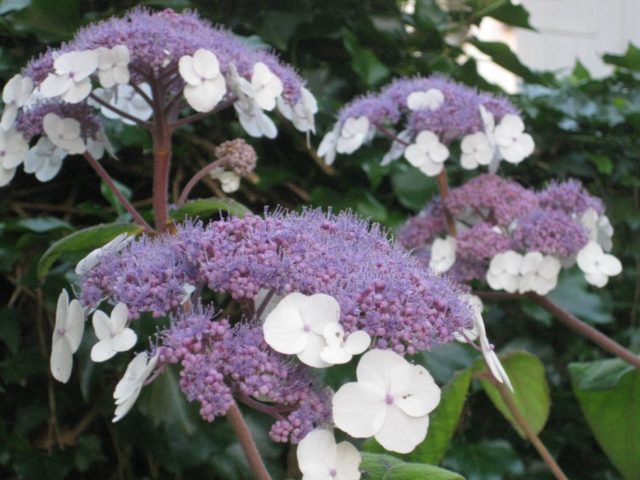

For the winter, the bushes of the plant need to be insulated
Description
The hydrangea family is native to Japan, but in the 19th century, the culture became popular in European countries. The first results of selection did not differ in good survival rate in the open field and frost resistance, the flower was considered exclusively indoor. After a while, breeders managed to breed several varieties of hydrangea with their own characteristic features.
So, one of the popular types of culture is rough hydrangea
... It is a tall bush (can reach 3 meters) with thick branches on which decorative leaves are located (dimensions 35x25 cm). Young foliage resembles dark green velvet. However, at the end of summer, it turns brownish orange.
The inflorescences ripen rather large. Most of them are painted in snow-white color. But there are lilac specimens with a lilac shade, differing in their small size
... The flowers are located in the middle. They, in turn, are surrounded by large white buds.
The flowering period lasts from August to September, which is a great advantage of hydrangea over other garden crops.
Rough (or rough) hydrangea has high winter hardiness.
This feature allows gardeners to grow the plant in almost any climatic conditions.
The only thing that is important to know is that with the arrival of winter, the shrubs need to provide good protection from wind and cold.
reference Information
Most of the plant species are shrubs (their height is 1 - 3 meters), some specimens are small trees, others are vines.
Crops are deciduous or evergreen. The most widespread are the first species, which are classified as plants of a temperate climate.
Hydrangea rough macrophylla
Hydrangea gets its name from the fusion of two Greek words (hydro - water, angelon - vessel). This means that the seed pods are like jugs, or the plants are very fond of moisture.
There is also a legend: in the 18th century, the Frenchman Philibert Commerson, a physician and naturalist, traveled across Japan. The sight of the flowering shrub fascinated him so much that he decided to name the plant Hortense in honor of his girlfriend.After all, none of the local residents could answer the name of the flower.
Varieties
Interestingly, this species has several varieties - consider the most popular ones.
- "Sargent".
This variety of garden flower is especially fond of Russian gardeners. Outwardly and to the touch, the foliage resembles velvet. In an open bud, the petals are located separately from each other. However, all the beauty lies in the combination of several shades of flowers - rich purple is replaced by pale pink, then turns into pale blue. Sometimes you can see small white spots. The bush grows quite large - up to 4 meters. The first flowering occurs at the end of August, lasts until the first snow.
- Hot chocolate.
This variety was obtained relatively recently. It is distinguished by large sterile flowers, painted purple in the center and pale pink at the edges. The buds are large - about 30 cm in diameter. In addition, the foliage of the Hot Chocolate is felt and rough. During the season it changes its color - from silver to olive. The bark and branches also lend themselves to changes - in winter they are set brown-red, reminiscent of chocolate. The same goes for foliage. The shrub begins to bloom in July, up to frost.
Annabelle
Hydrangea "Annabelle" is a variety with a "feminine" name, but with a "masculine character".
This is indicated by the high resistance of hydrangeas to frost, which is important for domestic gardeners. This variety not only tolerates winters well, but is also unpretentious in care, which will be a pleasant "bonus" for beginners in gardening. Representatives of the Annabelle variety are plants that reach 150 cm in height, while a hydrangea can grow up to 3 meters in diameter.
The leaves remain on the bush until the first frost and retain their decorative appearance. The leaves are quite large, the length can reach 15 cm, the color is rich green. Flowering begins in late June and early July and ends in early September. Small flowers, 1.5-2 cm in diameter, are collected in large inflorescences in the form of a "cap", which can reach a diameter of 30 cm. Tree hydrangea "Annabelle" after planting will delight your eye for 30-40 years.
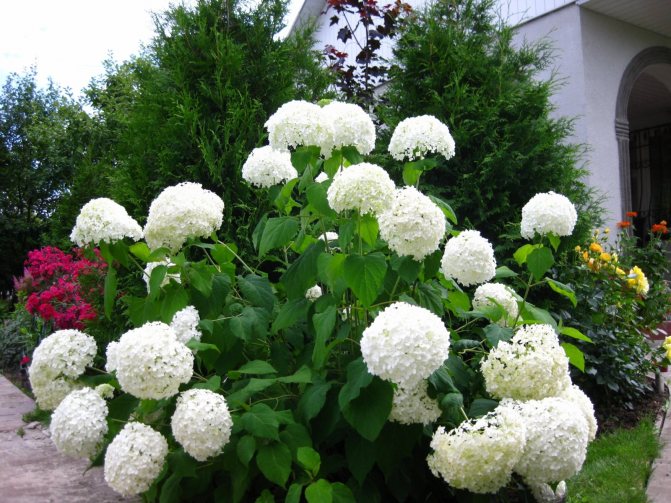

Did you know? For the first two years, all inflorescences with "Annabelle" must be removed in order for the plant to collect a "reserve" of nutrients and get stronger.
Landing
A suitable place for growing rough hydrangea is light, protected from drafts. It is not recommended to plant a young plant in direct sunlight, such an impact will negatively affect the development of hydrangea.
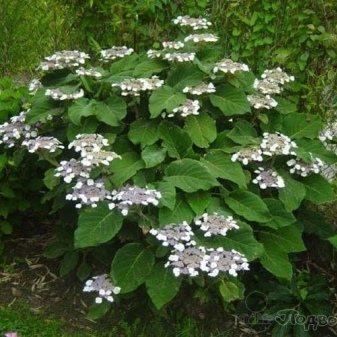

As for the soil, it is preferable to choose nutritious, neutral, maybe slightly acidified.
Before planting in a permanent place, it is necessary to prepare seedlings.
It is better to buy it in specialized flower shops or from trusted gardeners. It is recommended to choose a plant that is 2-3 years old.
You can plan a planting in the spring, immediately after the snow melts, or in the fall, preferably in September.


So, the landing technology involves the preparation of the pit. The depth is approximately 50-60 cm. A drainage layer of broken brick or crushed stone must be laid on the bottom. Fertile soil with humus and peat is poured from above. And also mineral fertilizers are added to this mixture.
An interval of 2 meters should be observed between the bushes.
The seedling is placed in a pit. When the tree is in the hole, gently straighten the roots. At the end, sprinkle with earth so that the root collar looks out. The last step is to water each bush abundantly with about two buckets of water.
Advice from gardeners: if planting is carried out on a dry day, the seedlings should be well sprayed with water.
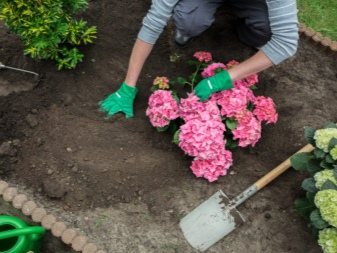

Planting hydrangeas in the garden
The flower bush does not like open spaces. He needs to be in the shade for part of the day. But you should not choose the dark part of the territory. Flowers are waiting for the sun.If you leave a hydrangea in the bright sun, it will simply burn out. At first it will become pale, then dry. The color saturation depends on the acidity of the soil.
There are not too many rules for working with varieties. Most of them are unpretentious, take root well and grow. A large beautiful flower bouquet is formed in one season.
Site selection and preparation
Be sure to select a place on the site for planting hydrangeas. Then they dig a hole. The size depends on the variety and root system. Standard pit size for a young bush:
- diameter - 0.5 by 0.5 m;
- depth - up to 70 cm.
If a mature bush is transplanted, they first dig a trench around it, roughly calculating the area of the bush. The following actions:
- a drainage layer is created at the bottom of the pit;
- peat is filled up;
- sand is added;
- needles or shavings are added about half;
- the top layer should be lighter.
Fertilizers are applied to the soil with an increased amount of alkali, which normalize the composition.
Features of hydrangea care (video)
Technology and timing of planting hydrangeas on the site
Seedlings are taken in late spring. First, the roots are examined, the damaged ones are removed, washed and straightened. Best planting time - September
... The plant will have time to gain a foothold in the soil and will be able to overwinter. If you work with a bush in the spring, the roots are pruned, but very carefully. It is advised to reduce the number of shoots, the length of the stems.
Care
Rough hydrangea is a moisture-loving plant. The process of development of root and deciduous systems directly depends on this indicator.
In addition, the lack of water negatively affects the flowering of the shrub. Therefore, the main care for hydrangea involves regular watering - at least 3 times a week. Each bush requires 4 buckets of water.
On cloudy days, irrigation will suffice.
Experienced gardeners use a mulch layer of peat to retain moisture in the soil.
Do not forget about loosening the near-trunk circles - quite twice a season.
In the first two years after planting, the hydrangea does not need feeding - the initial supply of nutrients in the soil has not yet been used up. And here A 2-year-old plant can be started with mineral fertilizers
... So, during the period of bud formation, superphosphate, mullein, potassium sulfate (ratio with water 1: 10) are ideal. To increase the strength of the branches, monthly irrigation of the bush with a solution of potassium permanganate (2 mg per 10 liters of liquid) will help.


From the third year, rough hydrangea should be cut off.
Usually this event falls on March-April. First of all, diseased, weak, damaged branches and shoots are removed. Further, last year's processes are cut off, leaving young buds.
Despite its resistance to cold weather, hydrangea needs shelter for the winter. For this, a layer of dry leaves, sawdust, felt, which is laid around the trunk, is suitable.
About the family "Hortensia"
Hortensiae are beautiful plants that originally appeared on Japanese soil, from where they migrated to the European continent (around the twenties of the 19th century). Until the 20th century, there were only two colors of this flowering plant - white and scarlet. It was at the beginning of the last century that they started breeding hydrangeas, as a result of which the plant became more resistant to cold and acquired various shades. Now the hydrangea has ceased to be only a room flower, it began to be actively grown in the personal plot.
The hydrangea looks like a shrub up to three meters high, there are varieties in the form of small trees, and some are a real liana.
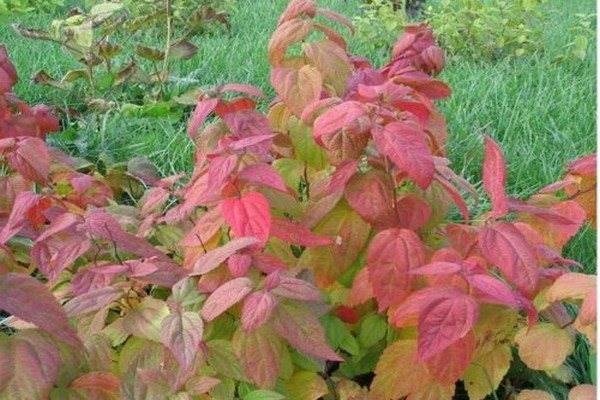

There are 2 types of hydrangeas - deciduous and evergreen. Deciduous - more common as it is adapted to moderate weather.
The name of the plant "hydrangea" in translation from Greek consists of "hydro" (moisture) and "angelon" (container or pot).What can this combination speak about? Maybe the fact that the box with hydrangea seeds resemble jugs? Or maybe the fact that a plant cannot live without water?
According to an ancient legend, a French naturalist traveling through Japan noticed a beautiful shrub. Nobody could tell him what these beautiful bushes are called. Impressed, he named the bush after his beloved.
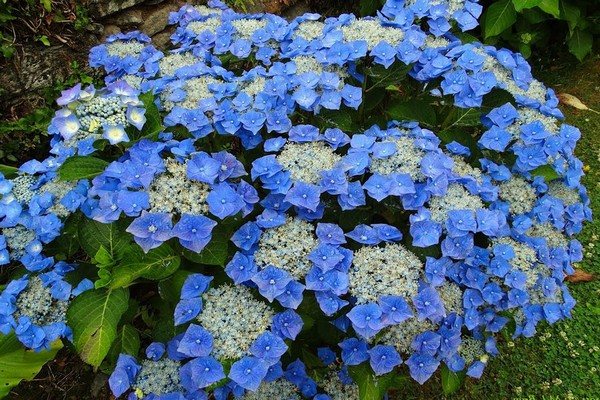

Reproduction
Garden culture reproduces in three ways.
- Seeds.
The containers are filled with moist soil, where the seeds are sown. Next, cover the seedlings with a glass plate or film. As it dries, the soil is moistened. After about 3 weeks sprouts sprout, and after a couple of years the seedlings are ready for planting in a permanent place. - Cuttings.
Processes with kidneys are cut off, placed in a glass of water. Then they are divided into parts, which are soaked in the Kornevin solution. Cuttings planted in the ground take root after 30 days. Young seedlings are planted as usual. - By dividing the bush.
First, the tree is dug up. The roots are cleaned of the earth, washed under the tap. The hydrangea divided into fragments is treated with Kornevin. I plant each part of the bush in the holes.
"Invincibelle Spirit"
Hydrangea tree-like variety "Invincibelle Spirit" is rightfully considered a "breakthrough" in the selection of hydrangeas.
This variety appeared in retail only in 2010 and has already gained popularity among gardeners. The homeland of the variety is the United States. The bush is 90-120 cm high, the diameter is up to 150 cm. The inflorescences of this variety are not very large, reach 15-20 cm in diameter, bloom dark pink, and over time the color becomes richer and brighter.
Inflorescences can be larger, up to 30 cm in diameter, subject to deep pruning. This variety is winter hardy and can withstand temperatures down to -37 ° C. Hydrangea blooms for four months: from June to September.
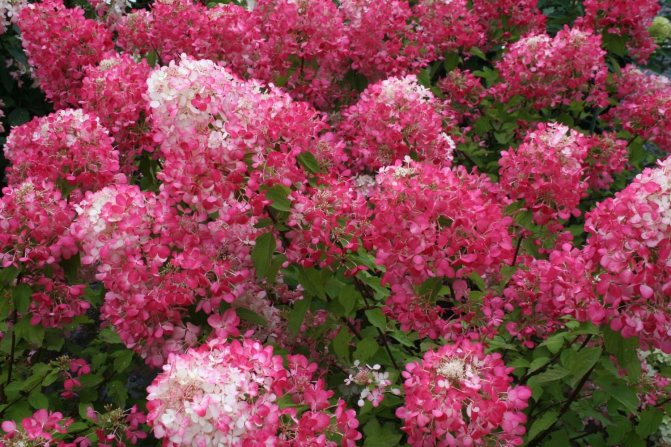

Diseases and pests
Rough hydrangea is quite resistant to various diseases. Despite good immunity, the plant is still exposed to infection or attack by pests.
- Chlorosis.
The disease is given by yellowed leaves, the veins of which become darker. The reason is an increased alkaline environment. A solution of ferrous sulfate (45 g per bucket of water), which needs to be sprayed on the affected tree, will help to fight the disease. - Powdery mildew.
In this case, the leaves become stained. Over time, it begins to darken. Treatment should be started as soon as the first symptoms are noticed. Gardeners recommend using Fundazol. - Spider mites, weevils, bugs, aphids.
Increased activity of pests is noted in cloudy, cold weather. The most effective remedies are insecticides.
Hydrangea Sargent (lat.Hydrangea aspera sargentiana)
- ornamental shrub; species of the genus Hortensia of the Hortensia family. Homeland is China. Differs in abundant flowering and large inflorescences that open at the end of summer. It is widely used in ornamental gardening. Tall appearance.
Characteristics of culture
Hydrangea Sargent is a flowering deciduous shrub up to 4 m high with a vertical crown and a low-branched wide-spread root system. Branches are thick, hard, dark, reddish in color, covered with short fleshy villi. Leaves are dark green, large, opposite, oblong-ovate, serrate along the edge, pointed at the ends, pubescent with sparse whitish hairs from the inside, rough to the touch, sitting on long petioles, up to 27 cm long.
Sterile flowers are white, fertile - pale lilac, collected in flat umbellate inflorescences up to 20 cm in diameter. Fruits are inconspicuous capsules. Hydrangea Sargent blooms in mid - late July, the fruits ripen in October. Fruits ripen extremely rarely, only in regions with warm autumn. The species under consideration is propagated vegetatively, the seed method is difficult. Hydrangea Sargent is not hardy enough, withstands frosts down to -23C.It needs shelter for the winter, without shelter, the above-ground part is very frozen, but with the onset of stable heat it quickly recovers.
Growing conditions
Hydrangea Sargent is an adherent of light, loamy, water and air permeable, well-moistened, slightly acidic or acidic soils. Will not tolerate dry, infertile, compacted, heavy and clay soils. Cultivation on alkaline soils with acidification is not prohibited. You can acidify the soil with needles, sawdust and tree bark, which can be collected from the nearby forest. The location is preferably semi-shaded, as for other members of the genus. It is not recommended to plant plants in open sunny areas, otherwise the leaves may get burned.
Reproduction
As mentioned, most often the Sargent hydrangea is propagated vegetatively, namely by layering and cuttings. The first method is the simplest. Both methods give 100% results even without the use of growth stimulants. Cuttings are harvested from strong shoots cut during spring pruning. Each stalk should contain 4-5 buds. Pre-cuttings are treated with a weak solution of "Kornevin", this procedure will speed up the rooting process. Cuttings are planted in a nutritious and moist substrate to the depth of two buds. For the first time, planting is shaded and systematically moisturized.
It is not forbidden to carry out summer cuttings, however, it rarely gives positive results. So, in the middle lane, summer cuttings are cut in the second decade of June (not earlier and not later). Cuttings are cut from healthy shoots located at the bottom of the bush. They should not have flower buds. The optimum length of the cuttings is 7-10 cm. The lower leaves are removed from the cuttings, the heel, along which the cut passed, is powdered with a growth stimulator "Kornevin". Then the cuttings are planted in the substrate for rooting and shaded. As a rule, summer cuttings take root in a month. But for this it is important to ensure regular watering and ventilation.
For the winter, young material is covered with spruce branches, the same operation is repeated from year to year, especially if Sargent's hydrangea is grown in regions with cold winters. Plants obtained by cuttings bloom for 2-3 years. The number of inflorescences formed depends on the age of the hydrangea. So, by the age of five, the plants form about 30 inflorescences, by the age of 10 - about 200 or a little more. Reproduction of culture by layering is no less effective than cuttings. To do this, the lower shoots are laid in the grooves, pinned, covered with fertile soil, gently pulled out the upper tip and placed at an angle of 45 degrees. For successful and fast rooting of cuttings, it is important to ensure good and abundant watering.
"Grandiflora"
"Grandiflora" - a variety of tree hydrangea native to the eastern part of North America, represented by a plant reaching 2 meters in height and up to 3 meters in diameter.
The spherical crown grows rather quickly, in a year it grows up to 30 cm in height and 30 cm in diameter. Light green leaves grow up to 16 cm in length. Inflorescences are white with a cream shade, up to 20 cm in diameter. This variety requires a lot of light, although it also develops well in partial shade, and a lot of moisture, while it does not tolerate drought. The plant is durable and can grow in one place for about 40 years. You can use "Grandiflora" in group and individual plantings, as well as a hedge.
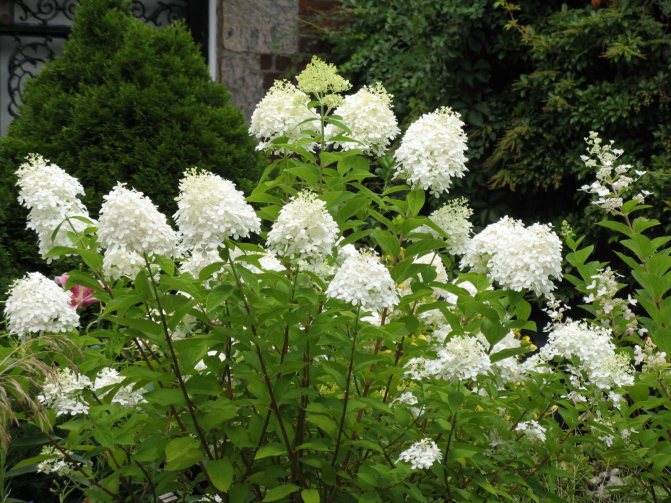

Southern regions of Russia
In the south of the country, all types of hydrangeas can grow and bloom beautifully, but due to high temperatures and dry winds, the plant requires planting either in the shade of trees or buildings. In addition, watering is carried out at the first signs of dry soil.
Large-leaved hydrangea
This is one of the most beautiful plant species. It blooms in large spherical inflorescences of different colors depending on the acidity of the soil.Demanding to care, grows better in partial shade, freezes, requires shelter, winter-hardy varieties are bred. It is better to grow in containers to bring it into the house for the winter.
Oak-leaved hydrangea
The leaves are similar to those of an oak tree. It blooms with white spike-shaped inflorescences. Valued for the color and shape of the leaves (see photo). Loves sunny areas, good at landscape design. It freezes in central Russia. Best varieties: Snow White Domes, Show Queen
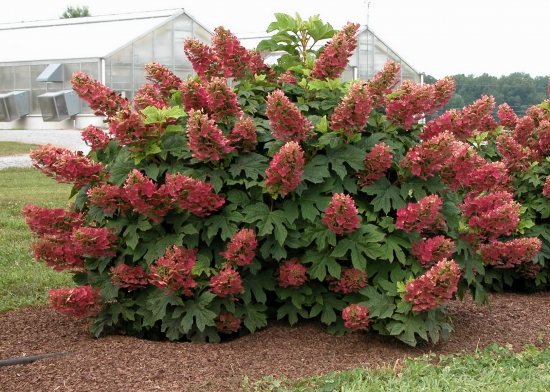

Ash hydrangea
The second name is gray, rarely grown in Russian conditions. Looks good in hedges, suitable for winter bouquets (see photo). Without cropping, it takes on a neglected look.
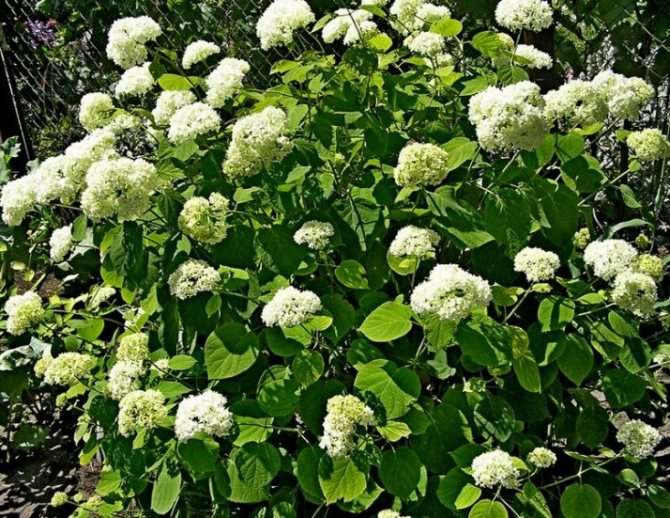

Hydrangea rough
Prefers fertile soil, does not like the sun and winds. The variety (Macrophylla) has gained the greatest popularity.


Serrate hydrangea
The plant has a beautiful color range and dependence on the composition of the soil. On alkaline soils, it becomes pink, on acidic soils - blue (see photo).
Serrated hydrangea Preziosa


Petiolate hydrangea
This variety is a vine and grows up to 25 meters. With the help of aerial roots, it clings to supports and braids the walls of the house, arches and gazebos. Flowers from white to lilac (see photo). Prefers shade. For winter, it is removed and covered with non-woven material. Listed in the Red Book.
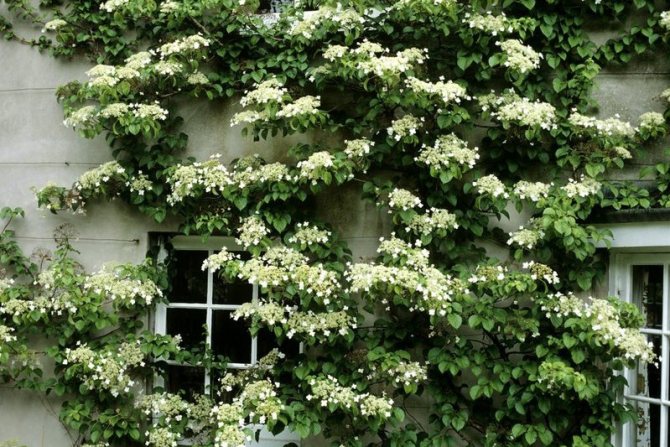

General characteristics of hydrangea for Russian gardens
The genus of the plant belongs to a large group of the hydrangea family. It includes small trees and bushes. There are more than 80 species of plants in the group. Hortense came to Russia from Japan. The plant emits such a distinct aroma that even a single small flower will create a pleasant summer incense. For a long time, flowers have adorned apartments, but breeders have created species that have adorned the plots. Hortense is no longer afraid of the cold climate, frost and rain. Thanks to the labors of scientists, lush buds became popular throughout the country.
Bush formation and pruning
Hydrangea tree-like pink is an ornamental plant and its appearance directly depends on quality care. Pruning also belongs to the main caring activities. Like many leafy shrubs and trees, hydrangeas need formative and sanitary pruning. In early spring, old, diseased branches, broken in winter or thickening the bush, are cut out. Since hydrangea loves semi-shaded places, the issue of thickening is acute: the lack of sufficient light and high humidity can provoke bacterial or viral infections in a dense overgrown bush. Therefore, crown rarefaction is so important: for productive development, each branch must receive enough sunlight. This is the role of sanitary spring pruning. At the same time, the crown of the bush is formed by shortening the annual shoots so that 5-6 pairs of growth buds remain on them.
The second time in the season, the hydrangea is pruned in the fall after flowering, removing dry inflorescences, broken stems and small shoots that have appeared.
Old, but productive bushes, which have grown and begin to lose their shape, can be rejuvenated in autumn by cutting off all the stems to a height of 20-30 cm. Fresh shoots will appear the next year.
Watering and loosening
Hydrangea pink, the planting of which is completed, must be generously watered with settled soft rain or melt water. Throughout the spring-summer season, this shrub needs abundant watering, preferably combined with sprinkling. The biological characteristics of hydrangea are such that, with a very high aboveground part, its root system grows horizontally, immediately feeling a lack of moisture during dry periods. Therefore, regular watering is vital for the shrub. In summer, he should receive 25-30 liters of water every 5-7 days, although moisture is adjusted, focusing on the weather conditions of the region.
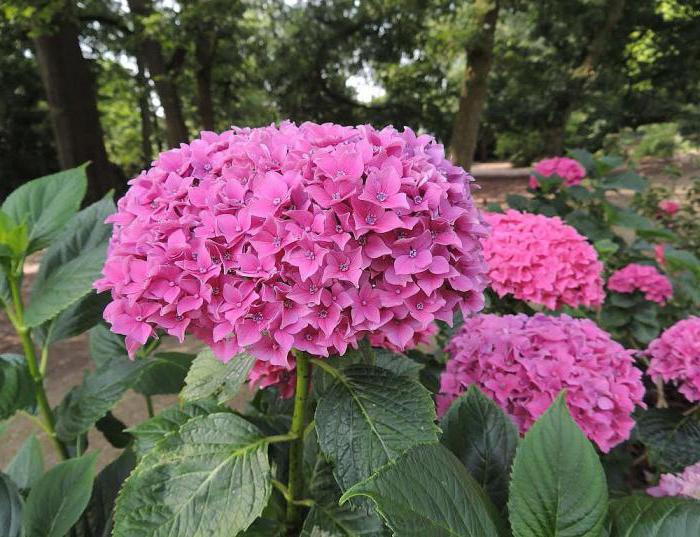

So that the ground under the bushes does not get seized by the crust, loosening is carried out, cultivating the area around the bush with a radius of 50-60 cm. Over the summer, the soil is loosened several times, simultaneously removing weeds. The depth of loosening is no more than 5-8 cm, since the roots of the plant are located quite close to the surface of the earth. Mulching with humus, peat, wood chips or plant debris has become a good alternative to loosening and weeding. This saves a lot of time for the gardener, retaining moisture under the bushes and preventing weeds from breaking through, but you should be sure of the quality of the mulch. Often, pests or bacteria are introduced along with it, provoking infections and diseases. This possibility should be foreseen and excluded.
Dividing the bush
There is another very effective method of propagation of such a plant as the pink hydrangea. The photo acquaints the reader with the division of the overgrown bush. Do this in the spring, carefully digging in the bush around the circumference. They gently shake off the soil from the hydrangea extracted from the ground, wash the root system under running water, examining the roots and removing damaged and rotten ones, then divide the bush into parts with a sharp clean knife, each of which should consist of aerial stems and healthy roots with several growth buds. Sections are treated with pharmacy brilliant green or garden varnish.
In the planting holes, prepared, as mentioned above, the resulting cuttings are seated, spilled with water with the addition of Heteroauxin or Kornevin to minimize stress, covered with soil and carefully tamped.
Testimonials
Marina
Hydrangeas are just super! First, I planted white ones on the site. But then I wanted to diversify and bought several bushes of pink hydrangea. I planted it according to the instructions, it seems to have taken root. I hope - they will delight me with beautiful flowers!
Alexei
I read somewhere that in our suburbs, only white hydrangeas grow, and to become pink, you need to water it with potassium permanganate. Then I subtracted that the soil should be alkaline, then the flowers will be exactly pink. My earth is acidic, so I will instill in bone meal so that it becomes alkaline. I really want a pink hydrangea.
Olga
I use special fertilizers as a top dressing for my plants. And if they are over, then I add humates. But it's important not to overfeed, so I sometimes feed mine. Pink varieties are even brighter in my opinion, steel, and the bush is stronger.
Description and appearance of the Candelite variety
Hydrangea Candelite (Hydrangea paniculata Candlelight) bred by Dutch breeders... The stem of a deciduous shrub reaches a height of 1–1.2 m. Its crown is dense, compact, grows up to 2 m. The shoots are strong, painted in a dark burgundy color. The leaves are decorated with fine teeth at the edges. They are elliptical in shape.
During flowering in July - October, large panicle inflorescences 30–35 cm long are formed on the bush. They resemble cones in shape. Cup-shaped flowers have 4-5 petals, colored in a creamy shade, which over time additionally acquires pinkish and reddish tones. The beauty of the described variety was appreciated by flower growers, and in 2013 the flower was awarded a silver medal at the world flower exhibition.
In various sources, you can find different spellings of the variety, for example, Candylight, Candle Light, Candy Light, Candylight. In translation, the name means "the light of a burning candle", which indicates the originality of the inflorescences. In the design of the garden, the described plant is used in single and group plantings, to create hedges and original mixborders.
Did you know? The name of the hydrangea is composed of two words from the Greek language, translated as "water" and "vessel". Linguists suggest that this name was given to the plant because of the external resemblance of seed pods to jugs or because of its great love for moisture.
"Sterilis"
Treelike hydrangea "Sterilis" is a variety that has a lower level of winter hardiness and needs mulching for both young and adult plants.
The bush reaches a height of 90-120 cm, and a diameter of up to 150 cm. The plant blooms in June and blooms until September. The flowers are white with a green tint over time, "cleared" of the green tint and become pure white. Large flowers are collected in medium-sized inflorescences. The shoots of this variety do not differ in elasticity and can bend under the weight of color and green mass. The leaves are light green, heart-shaped, growing up to 15 cm in length.
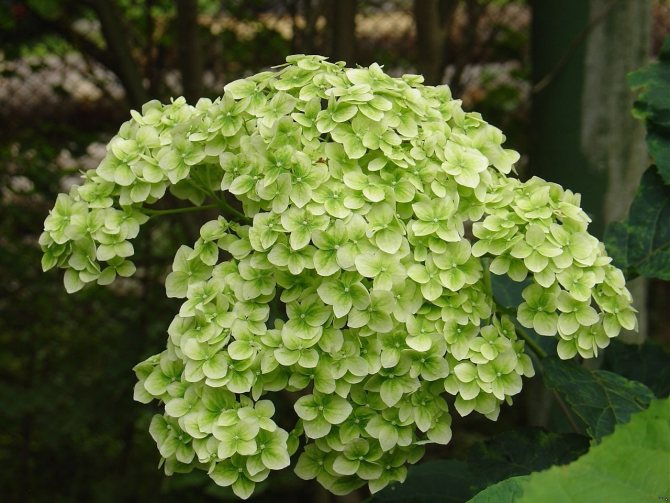

Did you know? The Sterilis hydrangea is often confused with the large-flowered hydrangea, but these two varieties still have a difference - Sterilis has a flatter flower.
Northwest region and Leningrad region
One of the best options, according to gardeners, for these regions is panicle hydrangea. Such varieties as Lime Light and Grandiflora bloom especially well and luxuriantly. The Polar Bear variety has shown itself well. The varieties are unpretentious and winter-hardy.
Treelike in these areas freezes and stops blooming, therefore requires shelter. You can also plant a serrated hydrangea with shelter. The large-leaved species requires a lot of energy and even if the seedling is purchased in a nursery. The advantage of this region is the acidic soil, which hydrangea loves very much.
The best varieties: Grandiflora, Polar bear, Far East
The Far East is the birthplace of hydrangea. The most common species in this region are paniculate and tree hydrangea. They do not require much attention and perfectly tolerate the climate of Primorye.
In this region, variegated hydrangea grows well, which is found in the wild in the forests of the Far East. Climatic conditions are also suitable for petiolate hydrangea. Gardeners leave it in a permanent place for the winter, because it does not freeze.
Recently, Russian gardeners have increased their interest in growing hydrangeas, especially since many new varieties have appeared.
The shrub during the flowering period is similar to multi-colored glades. Huge hats cover the greenery so tightly that the garden will simply smell sweet. The appearance of the buds is unusual, it is similar to small balloons of different colors. Due to its unpretentiousness, a variety of shades, hydrangea has become popular among Russian gardeners.
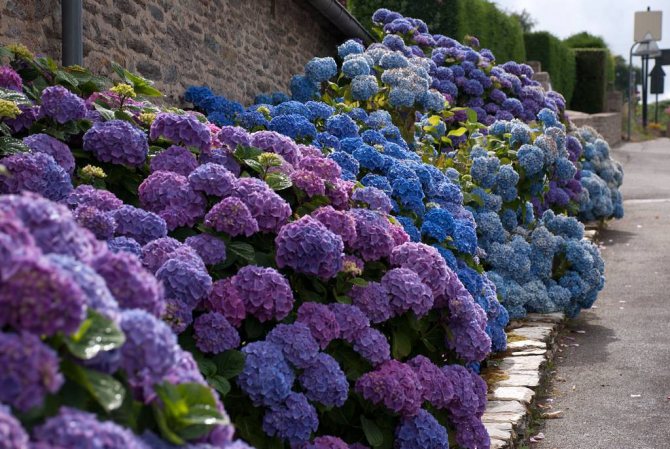

Due to its unpretentiousness, a variety of shades, hydrangea has become popular among Russian gardeners.
How to grow a pink hydrangea
The prevailing opinion about the excessive capriciousness of this ornamental shrub is highly exaggerated, since, like any plant, hydrangeas need care. Adherence to certain agrotechnical rules, acceptable for this particular culture, does not present any particular difficulties. Only if all the recommendations and advice of experienced gardeners are followed, the hydrangea will generously present with fireworks of mauve colors every year. She also has preferences, which you need to know about in order to create the most comfortable conditions for the productive development of the bush.
History


As scientists have proven, tree hydrangea is one of the most ancient plant species, which existed on the territory of the northern hemisphere forty or more million years ago, when the planet was still inhabited by dinosaurs.
But it was discovered as an ornamental plant much later, at the beginning of the eighteenth century, when the great botanist John Bartram on one of his expedition trips to North America, he discovered this flower, amazing in its unobtrusive, simple beauty.
Then there were years, decades of careful selection, improvement of the variety. As a result, by the twenty-first century, gardeners received the widest selection of hydrangeas, in which each person will find something of his own, according to his taste, according to the growing conditions, according to the characteristic features.But we will talk about the varieties of hydrangea a little later, and now about the rules of growing.
Hydrangea pink: problems and how to fix them
Usually, proper care provides an excellent decorative effect of the bush and a generous flowering. It is the flaws in caring activities that often lead to problems, for example, novice gardeners ask themselves why the pink hydrangea does not bloom. The main reasons here may be a lack of water, improper planting, a too sunny area, or too much fertilizing, which caused an intensive build-up of green mass to the detriment of the laying of buds. A detailed analysis of the operations performed will allow you to understand the cause and eliminate it.
We tried to tell you in detail about how to care for a pink hydrangea in the garden, the requirements of the plant and the main stages of care. Accurate adherence to the recommendations and advice will avoid problems in growing a shrub and annually enjoy the beauty of its long flowering.
Prevention measures
For preventive purposes, planting is regularly, throughout the growing season, treated with a solution of copper sulfate. To do this, add 15 g of dry matter to 10 liters of water and mix thoroughly. In the spring and autumn, the treatment is carried out with Bordeaux liquid, copper oxychloride, and chemicals as needed.
Plots are weeded regularly to remove weeds. They, together with the cut branches, are taken outside and burned. In order to avoid wintering of pests and larvae in fallen leaves, it is raked and utilized in the fall. To increase immunity and restore metabolism, fertilizing with a potassium nitrate solution is used: 100 g per 10 liters of water. After such treatments, watering is added using ferrous sulfate.
Careful care, watering and feeding will ensure a long life and full bloom of oak-leaved hydrangea for many years.
Ural and Siberia
All varieties have winter hardiness, "keep" the temperature up to 25-30 degrees of frost, recover well after freezing, abundant flowering. Treelike and panicle hydrangea varieties are recommended. It is better to use seedlings grown in the area. Dwarf varieties may be suitable for these regions. The poorly popular Bretschneider variety is suitable for the conditions of these areas.
In the harsh climate of the Urals and Siberia, shrubs need special shelters in the form of frames.
Dart's Little Dot
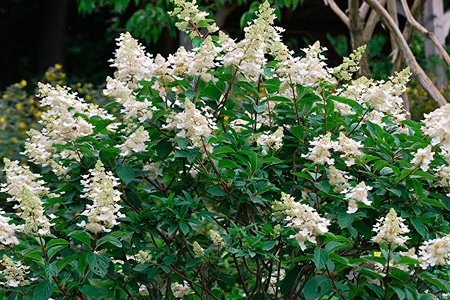

Top dressing
Immediately after planting, she is given urea, potassium, superphosphate. As soon as the first buds begin to form, the bush is given sulfuric potassium and superphosphate, but you do not need to feed it if the flowering is planned to be abundant. Before sheltering for the winter, the hydrangea is fertilized with manure or compost, which will help it survive the winter successfully. And next spring, as soon as the earth warms up, it is fertilized with urea, sulfuric potassium.
